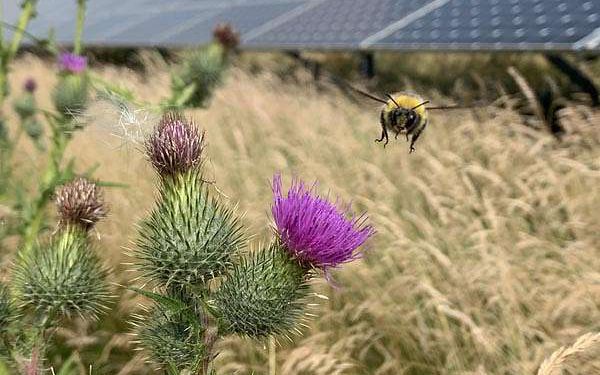Solar farms poised to shelter Britains bumblebees if managed for biodiversity
by Sophie Jenkins
London, UK (SPX) Oct 09, 2025
Solar farms in Britain could serve as important refuges for bumblebees, according to new research led by Lancaster University with the UK Centre for Ecology and Hydrology and the University of Reading. The benefits, however, are mostly confined to the sites themselves.
In field surveys, management approach was the dominant driver of bee numbers within solar farms. Sites with wildflower margins supported far more bumblebees than those maintained as turf. Modeling indicates bee abundance inside solar farms could more than double, rising by 120%, when sites are managed for biodiversity rather than grass-only cover.
“Our results indicate that well-managed solar farms could provide refuges to help protect localised bumblebee populations against landscape changes happening beyond the site boundaries,” said Dr Hollie Blaydes, Senior Research Associate at Lancaster University. “We expected to find that solar farms with more resources would support more bees, but we were also interested in how this management interacts with wider land use changes.”
Using a high-resolution modeling framework, the team evaluated how Britain’s 1,042 existing solar farms might bolster bumblebee populations under three future land use visions aligned to Representative Concentration Pathways and Shared Socioeconomic Pathways. Scenarios ranged from sustainable development to fossil-fuelled trajectories, downscaled from 1 km to 10 m resolution.
Across futures, surrounding landscapes shift substantially, with agricultural area declining in all scenarios due to factors such as changing diets and urban expansion. Researchers augmented maps with hedgerows and wildflower patches, then coupled them to a pollinator model that simulates foraging and nesting based on resource distribution, an unusually detailed approach for this kind of analysis.
The uplift from biodiversity-friendly management was largely localized: boosts in bee density remained mostly within solar farm boundaries and tapered off across wider foraging zones. In surrounding areas, overall landscape composition exerted a stronger influence on bumblebee densities than on-site practices alone.
A sustainability-oriented pathway that restores floral resources and habitat across the countryside delivered the most positive, far-reaching outcome, enhancing bumblebee densities both around and beyond solar farms. Strategic siting and network connectivity further improve prospects for pollinators at landscape scale.
Alona Armstrong, Professor in Energy and Environmental Sciences and co-author, said: “While benefits from solar farms for bumblebee densities may be limited to the local scale, our findings help to show that site management plays a role in supporting bumblebee populations. Solar farms could be considered as an emerging tool in conservation to help protect populations of bumblebees into the future.
“If we are going to need additional solar farms to meet our national renewable energy commitments, then strategic siting of solar farms could be considered to connect bumblebee habitats or provide bumblebee resources where they are otherwise limited.”
Dr Blaydes added: “Solar farms can be refuges for bumblebees in the present day and in the future and could play a part in mitigating habitat loss – if managed well. But, solar farms alone will not be able to counteract the effects of all future land use changes on bumblebees and other biodiversity.”
The peer-reviewed study, funded by the Natural Environment Research Council with support from Low Carbon, details these results and credits authors from Lancaster University, the UK Centre for Ecology and Hydrology, and the University of Reading.
Research Report:Solar farms as potential future refuges for bumblebees
Related Links
Lancaster University
All About Solar Energy at SolarDaily.com















